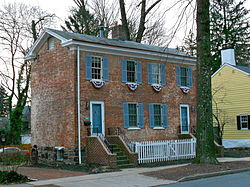Jugtown Historic District | |
 | |
| Location | Portions of Nassau and Harrison streets; Evelyn Place |
|---|---|
| Coordinates | 40°21′14.2″N 74°38′44.0″W / 40.353944°N 74.645556°W |
| Area | 15 acres (6.1 ha) |
| Built | 18th century - c. 1918 |
| Architect | Multiple |
| Architectural style | Queen Anne, Shingle Style |
| NRHP reference No. | 86003670 |
| NJRHP No. | 1737[1] |
| Significant dates | |
| Added to NRHP | January 22, 1987 |
| Designated NJRHP | December 16, 1986 |
The Jugtown Historic District consists of a cluster of historic buildings surrounding the intersection of Harrison Street and Nassau Street in Princeton, New Jersey. The settlement dates to colonial times and is sometimes known as Queenston. In 1987, the district was listed on the National Register of Historic Places.
The community's first structure dates to 1730, coinciding with its mid-century growth as a crossroads settlement. A number of potteries in the area earned the village the name Jugtown. The 19th century saw the community to grow, spurred by commercial development and trade on the Delaware and Raritan Canal. The latter half of the century saw the decline of Jugtown's industry. It was home to the short-lived Evelyn College for Women from 1887 to 1897. The district's character became mostly residential in the 20th century. Although the historic district was established in the 1980s, concerns over further development have arisen due to municipal zoning overlays.
- ^ "New Jersey and National Registers of Historic Places — Mercer County" (PDF). New Jersey Department of Environmental Protection — Historic Preservation Office. April 5, 2013. p. 8. Archived from the original (PDF) on May 16, 2013. Retrieved June 4, 2013.


